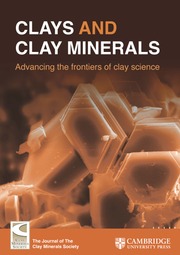Crossref Citations
This article has been cited by the following publications. This list is generated based on data provided by
Crossref.
Ferretti, Rachel
Zhang, Jingwu
and
Buffle, Jacques
1998.
Flocculation of Hematite with Polyacrylic Acid: Fractal Structures in the Reaction- and Diffusion-Limited Aggregation Regimes.
Journal of Colloid and Interface Science,
Vol. 208,
Issue. 2,
p.
509.
Zhang, J
Huguenard, C
Scarnecchia, C
Menghetti, R
and
Buffle, J
1999.
Stabilization and destabilization of hematite suspensions by neutral and anionic polyacrylamide.
Colloids and Surfaces A: Physicochemical and Engineering Aspects,
Vol. 151,
Issue. 1-2,
p.
49.
Derrendinger, Luc
and
Sposito, Garrison
2000.
Flocculation Kinetics and Cluster Morphology in Illite/NaCl Suspensions.
Journal of Colloid and Interface Science,
Vol. 222,
Issue. 1,
p.
1.
Field, M.Paul
and
Sherrell, Robert M
2000.
Dissolved and particulate Fe in a hydrothermal plume at 9°45′N, East Pacific Rise:.
Geochimica et Cosmochimica Acta,
Vol. 64,
Issue. 4,
p.
619.
Lima, Jose M.
Anderson, Sharon J.
and
Curi, Nilton
2000.
Phosphate‐Induced Clay Dispersion as Related to Aggregate Size and Composition in Hapludoxs.
Soil Science Society of America Journal,
Vol. 64,
Issue. 3,
p.
892.
Waite, T.D.
Cleaver, J.K.
and
Beattie, J.K.
2001.
Aggregation Kinetics and Fractal Structure of γ-Alumina Assemblages.
Journal of Colloid and Interface Science,
Vol. 241,
Issue. 2,
p.
333.
Yan, Y.D
Burns, J.L
Jameson, G.J
and
Biggs, S
2002.
Viscosity Effect on the Structural Compactness of Latex Flocs Formed under Weak Depletion Attractions.
Journal of Colloid and Interface Science,
Vol. 255,
Issue. 1,
p.
91.
Tombácz, E.
2003.
Role of Interfaces in Environmental Protection.
p.
397.
Ferretti, Rachel
Stoll, Serge
Zhang, Jingwu
and
Buffle, Jacques
2003.
Flocculation of hematite particles by a comparatively large rigid polysaccharide: schizophyllan.
Journal of Colloid and Interface Science,
Vol. 266,
Issue. 2,
p.
328.
Tombácz, Etelka
Libor, Zsuzsanna
Illés, Erzsébet
Majzik, Andrea
and
Klumpp, Erwin
2004.
The role of reactive surface sites and complexation by humic acids in the interaction of clay mineral and iron oxide particles.
Organic Geochemistry,
Vol. 35,
Issue. 3,
p.
257.
Pierangeli, M. A. P.
Guilherme, L. R. G.
Curi, N.
Anderson, S. J.
and
Lima, J. M.
2004.
Adsorção e dessorção de cádmio, cobre e chumbo por amostras de Latossolos pré-tratadas com fósforo.
Revista Brasileira de Ciência do Solo,
Vol. 28,
Issue. 2,
p.
377.
Ren, Jianhong
and
Packman, Aaron I.
2005.
Coupled Stream−Subsurface Exchange of Colloidal Hematite and Dissolved Zinc, Copper, and Phosphate.
Environmental Science & Technology,
Vol. 39,
Issue. 17,
p.
6387.
Berka, Marta
and
Rice, James A.
2005.
Relation between Aggregation Kinetics and the Structure of Kaolinite Aggregates.
Langmuir,
Vol. 21,
Issue. 4,
p.
1223.
Peker, Sümer
2006.
Colloid Stability.
p.
73.
Chorover, Jon
and
Brusseau, Mark L.
2008.
Kinetics of Water-Rock Interaction.
p.
109.
Alimova, Alexandra
Katz, A
Orozco, Julian
Wei, Hui
Gottlieb, Paul
Rudolph, Elizabeth
Steiner, J C
and
Xu, Min
2009.
Broadband light scattering measurements of the time evolution of the fractal dimension of smectite clay aggregates.
Journal of Optics A: Pure and Applied Optics,
Vol. 11,
Issue. 10,
p.
105706.
Peker, Sümer
2010.
Colloid Stability.
p.
73.
Subasinghe, Nalaka Deepal
2011.
Electron Microscopic Studies on Phosphate Binding Processes in the Presence of Iron.
Advanced Materials Research,
Vol. 343-344,
Issue. ,
p.
307.
England, Dustin
Tambe, Nikhil
and
Texter, John
2012.
Stimuli-Responsive Nanolatexes: Porating Films.
ACS Macro Letters,
Vol. 1,
Issue. 2,
p.
310.
Mellis, Estêvão
Casagrande, José
Soares, Márcio
da Cruz, Mara
and
de Camargo, Otávio
2012.
Competitive Sorption and Transport of Heavy Metals in Soils and Geological Media.
p.
171.

